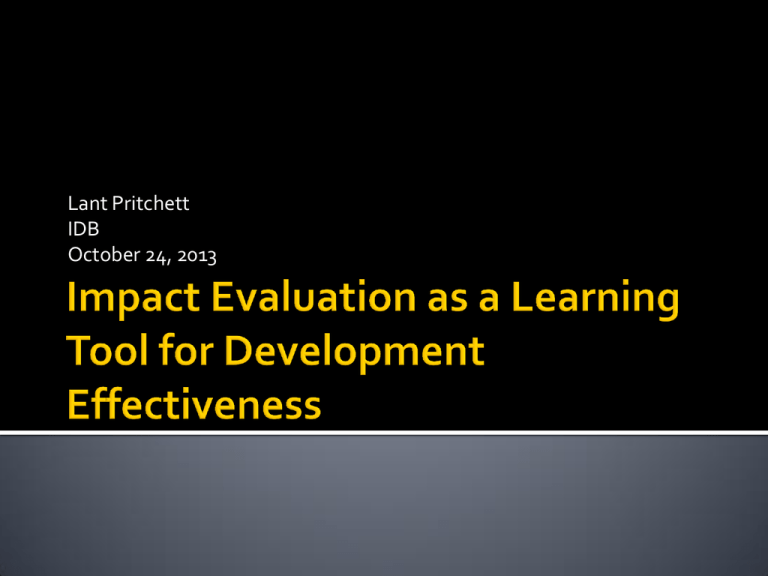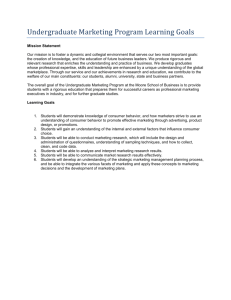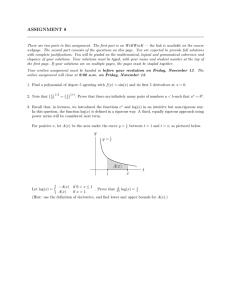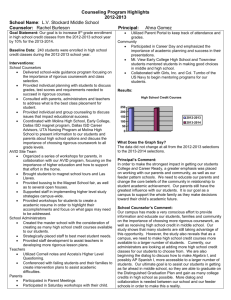Lant Pritchett IDB October 24, 2013
advertisement

Lant Pritchett IDB October 24, 2013 Most of the rhetorical claims about the importance of “rigorous” impact evaluation for development are without any evidentiary basis, empirically wrong, scientifically naive The future is be build more rigorous methods into a realistic positive model of (a) policy changes, (b) organizational capability for implementation and (c) domain relevant learning Our research agenda is working on (b)—Problem Driven Iterative Adaption (PIDA) and (c) MeE (Monitoring, experiential learning, and Evaluation) as a sub-component of that. RCT AS A WAY TO DO RESEARCH RCT AS A DEVELOPMENT PROJECT The “identification” problem bedevils attempts to extract empirical estimates of either “deep structural parameters” or causal impact from nonexperimental data. The claim is that only experiments (or ‘as good as’) can produce “rigorous” evidence. “Development project” is the use of inputs to produce outputs to affect outcomes of human well-being in developing countries. An effective development project must be based on a complete and coherent causal change from action to outcome—with a correct positive model of all actors. Claims that RCT evidence is more “rigorous” are incoherent and indefensible (paper with Justin Sandefur) Simplest possible (e.g. OLS) contextual evidence can be better at predicting casual impact than RCT evidence from another context—depends on variances and mostly seem to go the wrong way for RCTs (e.g. true contextual variation bigger than methodological error) MOST USES OF RIGOROUS EVIDENCE AREN’T RIGOROUS Citaions of Olken 2007 50 13 40 number of citations EXTERNAL VALIDITY CLAIMS ARE ESSENTIAL BUT WRONG 30 20 34 10 3 0 5 2 From a Paper about From a Paper about From a Paper about a Indonesia another Country in Country in a East Asia Pacific Different Region or Region Not about a Sepcific Mention External Validity or Context Country or Region Do not Mention External Validity or Context Wrong mode of what is important for well-being and whether or not RCTs are even possible for those topics Wrong about the positive model of the adoption of “better” policy or practices Wrong about the model of capability for policy implementation (outside of a narrow range of mostly already done things) Wrong about learning (outside a narrow range of things) National development is a four-fold transition to more productive economies (citizens are prosperous), more responsive polities (citizens control sovereign), capable administration (collective action is effective) and social equality (treatment not conditioned on birth) Get those right and all issues of absolute deprivation in the world are solved—the independent role for “policy” is small (as its endogenous) Source: Kenny and Pritchett (2013) SOCIETY MEASURES End of colonialism Economic growth—rapid in many, constant in many (some laggards) Push for greater social equality (end of apartheid, erosion of caste) Massive increase in democracy INDIVIDUALISTIC MEASURES Rising incomes Declining poverty Rising education levels Rising health Lowered fertility/population growth Greater human equality in treatment Greater individual freedoms HYPOTHESES ABOUT LEARNING IN SCHOOL Policy should be based on existing evidence New evidence should produce policy changes REALITY CHECK People should be seeking new evidence Wrong. Marginal product per dollar off by orders of magnitude compared to efficiency Wrong. Weak relationship between what is adopted (e.g. smaller class sizes) and what has evidence Wrong (and selfcontradictory). People don’t want it Lowered and tamed inflation Spread of cell phones Improvement in health indicators Expansion of schooling Higher growth in India, China, Vietnam (etc.) Gains from post-reform growth (relative to counter-factual) adjusted to OECD marginal utility in trillions 4500 4000 3500 Acutal 3000 2500 2000 1500 Zero Growth 1950-1990 growth 1000 500 0 Marginal utility: Constant GDP per capita (PPP) 2006 1999 1992 1985 1978 1971 1964 1957 1950 1/y 1/y^2 Counter-factual “without reform” growth rate 0% 2% $2.10 $1.18 $20.63 $11.57 $202.47 $113.49 Cumulative global aid, 19701990: ~1 trillion US GDP 12 trillion Widjojo, the Indonesian economist Total gains in trillions Relative to Gains Counterwith factual growth log rate of: Utility 0 2 ppa (2 ppa) Country Growth Episode Indonesia 19662007 1.22 0.70 5.91 Vietnam 19862007 0.21 0.15 1.68 Models of policy often either ignore policy implementation or have a “capacity” model of “training” workers to follow a script. But studies are showing “implementation” is a key constraint (e.g. “Band-aids on a corpse”) in the sense that RCTs cannot implement the intervention as designed to evaluate its impact, if implemented Bold et al 2013 show that “rigorous” evidence about impact does not generalize across organizations even in the same country as the “same” intervention had different impacts when scaled Taxonomy of activities by implementation intensity Implementation Light: Policy or Concentrated elite services TI LD HS KT HS KT Logistics TI LD Implementation Intensive Service Delivery Policy TI LD HS KT Implementation Intensive Imposition of Obligation TI LD Wicked Hard HS KT TI LD HS KT THE HEAD HAS TO COME OUT FOR THE BODY TO MOVE ORGANIZATIONS CAN SURVIVE EXTERNAL ATTACK…BY NOT MOVING 1. Local Solutions for Local Problems 2. Pushing Problem Driven Positive Deviance 3. Try, Learn, Iterate, Adapt (MeE) 4. Scale Learning through Diffusion This section is based on Andrews, Pritchett and Woolcock 2013 (forthcoming) Use “M” (which exceeds “E” by order of magnitude) as part of learning Use “supervision” as a structured learning exercise. Allow implementers to “crawl the design space” in search of what works before (or along with) “external” big E “Communities of practice” will be resistant to impact evaluation that is seen (correctly) to be hostile to their interests (“It Pays to be Ignorant” (Pritchett 2004) Within “Communities of Practice” only learning is learning—that is practices diffuse rather than are imposed. Next generation “evaluation” has to balance being a tool of fiduciary accounting and providing practitioners more effective accounts





![Gunning presentation [PPTX 699.68KB]](http://s2.studylib.net/store/data/014976236_1-85e3268015b810d2235568b8329b35de-300x300.png)